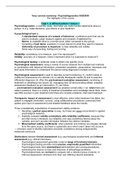Very concise summary– Psychodiagnostics GGZ2030
The highlights of the course
Task 1: A difficult patient + lecture 1
Psychodiagnostics: a scientific study, that helps you make funded statements about a
person, to e.g. make decisions, give advice or give treatment.
A psychological test is:
- A standardized measure of a sample of behaviour: a reference point that can be
used to evaluate, judge measure against and compare. Established by:
- Norms: to establish what is a normal score (often compared to the group).
- Consisting of test items: questions in a test relevant to what they want to measure.
- Uniformity of procedure is important: to help reliability and validity.
Same way of presenting, testing and scoring.
Reliability: consistency of a measure. (can it be reproduced?)
Validity: accuracy of a measure. (does it represent what it is supposed to measure?)
Psychological testing: a particular scale to obtain one specific score.
Psychological assessment: using a variety of scores obtained from multiple test methods
in combination with historical information, presented complaints, observations, interviews and
third party-information to understand the person being diagnosed (multiple scores).
Psychological assessment is used to describe current functioning (1), confirm refute or
modify the impressions of a clinician (2), to identify therapeutic needs (3) and to examine
differential diagnosis (4). After this pre-treatment evaluation assessment, monitoring of
treatment or identifying new issues (5), managing risks (6) and providing skilled, empathic
assessment feedback as an intervention (7), can follow.
→ pre-treatment evaluation assessment has greatest overall utility (1-4), when there are
salient questions, there’s a variety of treatment possibilities and knowledge about them, there
was little success in prior treatment and there are complex problems, that need treatment.
Therapeutic impact of assessment is most effective, when initial treatment has failed, the
patient is engaged (motivated, curious), using collaborative procedures, (personal) third
parties give input (in assessment) and detailed feedback about the results.
Three unrealistically expectations of assessment validity evidence;
1. Recalling a perfect association is easy, but these are never encountered in applied
psychological research.
2. Implicitly compare validity correlations with reliability coefficients, because they
are often know in literature, but reliability only says something internal about the
variable, and can’t provide information between two distinct variables.
3. Monomethod validity coefficients: when predictor and criterion are (largely) derived
from the same source, but there is systematic error which aren’t taken into account.
→ clinicians need to identify replicated univariate correlations among independently
measured constructs.
Distinctions between formal assessment (e.g. psychological assessment) and informal
assessment (e.g. clinical interviews)
- Psychological assessment generally covers a range of functional domains.
- Psychological testing provides more precise, empirically quantified information.
- Psychological tests have standardized administration and scoring procedures,
minimizing the chance on bias and reduction of ethical/legal problems.
- Psychological tests are normed (to compare with a relevant group of peers). In
informal assessment clinicians form their own differing internal standards.
, - Psychological tests have been researched on reliability and validity.
- Test-batteries are used in formal psychological assessment:
→ test batteries: a range of methods to obtain information and cross-check hypotheses.
Cross-method agreement: there is a more complete representation with the use of multiple
methods, on what the psychologist wants to know.
Low cross-method correspondence: independence among psychological methods. This
can lead to complexity. clinicians should be aware of strengths and limitations of
assessment methods and select methods based on their knowledge and hypotheses.
Assessment methods:
1. Unstructured interview: elicit information about someone’s life narratives,
constrained by a range of topics and chance of interpretation.
2. Structured interview and self-report instruments: concerns patients’ own
understanding and experience, limited by his judgement and motivation.
3. Performance-based cognitive tasks: findings about problem solving and functional
capabilities, limited by motivations, engagement and setting.
4. Observer rating scales: the informants perception.
Clinicians have limited capacity to make reasoned, individualized judgements from test
scales alone. The value of tests is better when they are viewed in different contexts.
Meyer: Validity of psychological tests is strong and comparable (maybe even better) than
medical tests. Effect size (R): shows how well a measure predicts the outcome, it scores
between 0 and 1, the higher the better prediction.
→ the multimethod assessment battery provides a structured tool for skilled clinicians to
maximize the validity of individualized assessment.
The empirical cycle: a model to answer questions in scientific research.
Observation: collecting and classifying empirical materials to form a basis for
creating a theory of why and how the problems exist and persist.
Induction: the formulation of the theory and hypotheses about the problems.
Deduction: tools are selected and testable predictions are derived from these
hypotheses.
Testing: materials are used to determine whether predictions are right or not.
Evaluation: accepting or rejecting the hypotheses. Evaluate: Do we need to go
through the cycle again?
The diagnostic process:
Clinical diagnostics is based on 3 elements: forming a theory of the problems, complaints
and/or problematic behavior (1), operalization and measuring (2) and applicating relevant
diagnostic methods (3). This is a scientifically thought to action process to make responsible
statements about a client.
The 5 basic questions in clinical psychodiagnostics:
1) Recognition: What are the problems; what works and what doesn’t?
2) Explanation: Why do certain problems exist and what perpetuates them?
3) Prediction: How will the client’s problems subsequently develop in the future?
4) Indication: How can the problems be resolved?
5) Evaluation: Have the problems been adequately resolved as a result of the
intervention?
Most requests contain 3 basic questions: recognition, explanation and indication. But in
practice all of the basic questions are often examined simultaneously.
, Recognition: identifying complaints and behavior to understand the client’s problem.
This contains investigating, describing, organizing and categorizing of the complaints’,
followed by an examination of seriousness of the problem.
Recognition may occur after:
Criterion-oriented measurement: comparison to a predefined standard.
Normative measurement: comparison to a representative comparison group.
Ipsative measurement: comparison to the individual itself (e.g. in previous times)
→ classification: the clinical picture. Based on all-or-nothing principle (e.g. DSM-5) of
more-or-less principle (e.g. testing).
→ The diagnostic formulation is a complete, multidimensional description of the patient,
often involving recognition and explanation. This helps with treatment planning.
Explanation: looking for answers to why there is a problem and why it perpetuates.
Explanation looks for the causal relationship between the main problem and the conditions
that explain its occurrence. Explanation can be classified according to.
The locus: where is the explanation?
Personal oriented: the explanation lies in the person himself (separately
from the context.
Situation oriented: in the event of a well-known context. Explanatory
events often precede the behavior that is to be explained or follow it.
The nature of control:
Cause: determines behavior by previous conditions.
Reason: explanatory factor: determined by a voluntary or intentional
choice.
Synchronous and diachronous explanatory conditions.
Synchronous explanatory conditions: coincide (vallen samen) with the
behavior that is to be explained at the time.
Diachronous explanatory conditions: precede this behavior (prior to the
behavior).
Induced and persistent conditions:
Induced conditions: produce - give rise to a behavioral problem.
Persistent conditions: maintains – perpetuate the behavioral problem.
In therapeutic situations it is best to search for conditions and factors in current
situations, that perpetuate the problem, because we can influence these.
Prediction: making statements about the development of the problem in the future.
Determining the relationship between the predictor (present behavior) and the criterion
(future behavior) based on research and meta-analyses. to choose the right treatment.
Risk assessment: determine the chance that behaviors will occur (in a population).
Indication: a search process for the right, suitable, required treatment for a specific client.
This can only be done after recognition, explanation and prediction. It is important to be
aware of the available treatments and therapists, the usefulness of treatments and the
acceptance of indication by clients’. Take the clients’ preference into account.
Evaluation: the claims about the diagnosis and/or intervention are evaluated based on the
progress of the therapeutic process and the results of treatment.
The diagnostic process/cycle contains five steps:
Application
Exploration
Request: information about the referrer. (e.g. his vision, education and
experience)
Request for help: details about the type and content of the request.
• Open-ended format: the referrer doesn’t suggest a hypotheses.





